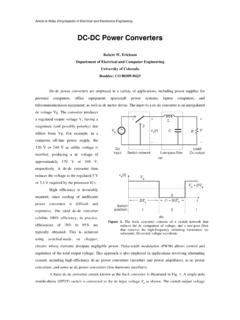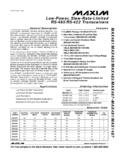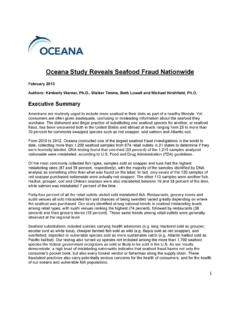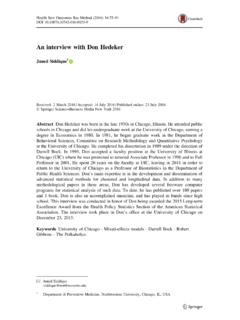Transcription of How to Write a Technical Paper: Structure and Style of the ...
1 How to Write a Technical Paper: Structure and Style of the Epitome of your Research Georgios VarsamopoulosDepartment of Computer Science and EngineeringArizona State UniversityTempe, Arizona, major problem that young researchers face istheir inability to Write good research papers. Thisdocument serves as a guideline on how to Write agood Technical paper . It contains ideas that havebeen gained through experience; skilled authorswill find themselves familiar with these ideas. Thedocument is formated and structured like a typicaljournal publication. Each section describes whatyou should discuss in abstract is what a person always reads firstin a Technical paper . Based on the content of theabstract, the reader will decide whether the pa-per is worthy enough to merit further study.
2 Theabstract should classify your research and contri-bution in the research areas. It should containthe following four parts: a brief introduction de-scribing the discipline that the paper belongs to;a clear and concise statement of your problem;a brief explanation of your solution and its keyideas; a brief description of the results obtainedand their impacts. Lastly, provide a short list ofindex keyword : writing guides, writing Technical papers,format guides1 IntroductionThe introduction serves a twofold purpose. Firstly, itgives the background on and motivation for your research,establishing its importance. Secondly, it gives a sum-mary and outline of your paper , telling readers what they The title states the contribution of a paper in one the very first words of a paper , often it is the last to bedecided in the authoring process.
3 The most usual format of title is A [adjective] [approach] for [problem] in [environment] ,although there is no standard to Write a title. This document was produced on September 14, 2004should expect to find in you Write the background review, you shouldconsider including technological trends of the area, openproblems and recent promising developments. At thispoint, you can introduce more specific terminology whichis not widely known. Provide good motivation for yourwork, such as explaining its technological, research or eco-nomic importance. The motivation should not be elab-orate; simply two or three good reasons are enough tomake your research summary should include a problem description,which is slightly more detailed than in the abstract.
4 Thesummary should also include a description of your so-lution and some arguments on its impacts. In the de-scription of your solution, include its key concepts andcategorize its your introduction with a description of your pa-per outline, what sections it contains and what the readerwill find in each. After completing the introduction, read-ers will decide if they want to paper should flow smoothly. Readers should neverfeel as if they are missing information a Technical paperis not a novel. A proper flow is to first set thecontext,then present yourproposal, then provide theverification,and lastly wrap up withconclusions. Figure 1 gives themain sections of a paper . Introduction, related work,system model and problem description set the context,followed by the presentation of your solution.
5 Analysis,simulation and experimentation make up the verificationpart. Lastly, conclusions and future work make an evalu-ation of your solution according to the verification Related WorkThe purpose of the related work section is the most mis-understood by young authors. Therefore, it is importantto pay extra attention in writing this section. Similarto the introduction, the purpose of the related work istwofold. First, it gives a list of research works that are1 IntroductionProblem StatementYour solutionAnalysisSimulationConclusionsFut ure WorkRelated WorkSystem ModelExperimentationFigure 1:The Structure of a typical Technical paperrelated to your paper necessary to show what has hap-pened in this field. Secondly, it provides a critique of theapproaches in the literature necessary to establish thecontribution and importance of your a related work section shows that you havedone your homework.
6 In this aspect, it is importantthat your related work section be as complete as possi-ble. By complete, it is not meant that you should list allthe existing publications on the subject this would besomewhat hard but mostly meaningless; on the contrary,you should distinguish and describe all the different ap-proaches to the problem. Ideally, a person who chooses tofocus on the area of your paper should only read your pa-per to catch up with the background work in the , a good background work survey will deter thepossibility that your solution has already been proposedby others. In time, you will realize that the most impor-tant works are found only in journals or in proceedings ofmajor conferences. Although you have probably studiedpublications from other sources, you will end up citingonly the important the major approaches of the backgroundwork will enable you to identify the limitations of theother works and show that your research picks up wherethe others left off.
7 This is a great opportunity to demon-strate how your work is different from the rest; for ex-ample, show whether you make different assumptionsand hypotheses, or whether your approach to solving theproblem System ModelIn the system model section, you explicitly describe all thehypotheses and assumptions of the environment on whichthe problem will be stated. Put good effort in realizingall explicit and implicit assumptions that you make, andclearly state them. It is important to provide support foryour assumption choices. The more valid and acceptableyour assumptions are, the more valid and acceptable yourwork will system model section should always have a figure should demonstrate the parameters of yoursystem model. Prepare the figure so that it can later bereused or enhanced to demonstrate your Problem StatementOften, this section is merged with the system your problem clearly.
8 Be as exact as possible intostating what the question of the problem is. It reflectspoorly upon an author if he cannot describe or does notknow what problem his solution addresses. But most im-portantly, it will be easier for successive researchers toclassify your SolutionYou should begin this section by providing an overview ofyour solution. Give a good explanation of its rationale,concepts and mechanisms. If your solution relies on atheorem or some other undocumented concept, make surethat you explain them before you carry on to the main part of this section is the thorough descrip-tion of the solution and its functionality. The descriptionshould not contain arguments on correctness or design de-cision debates; simply, describe the mechanisms of yoursolution and avoid explanations of the why so a separate paragraph or two on the latter, ifyou deem your solution to its functional componentsand explain them separately.
9 For example, if you describea distributed algorithm, explain the protocol-specific part(message format, etc.) separately from the semantics anddecision-making part of the is both important and useful to provide figuresdemonstrating the functionality of your solution. Makethe figures look similar to the system model figure, if ap-plicable, and exploit the similarities and differences topoint out important aspects of your AnalysisAnalysis can be of two former means to show some properties (qualities)of your solution, while the latter means to show someperformance aspects of your analysis is usually proof of correctness,however it could be proof that the solution possesses somedesired property. For algorithms or protocols, a proof ofcorrectness is always analysis is mostly performance is important to explain what performance metric youuse and why you have selected the specific metric.
10 Choos-ing a metric that has been widely used will make thecomparison to other solutions Simulation and Experimenta-tionDepending on your budget and available time, you mayhave performed simulations or even some experiments. Ineither case, it is important to describe the environmentof your experiments or simulations. This includes statingthe parameters and conditions of the environment (sim-ulated or real), what measurements were taken and howthey were need to establish the fact that your simulation orexperiment results arestatistically stable, meaning thatthey are representative of the space of possible experiments and simulations is a subtle mat-ter, always putting the validity of your data at risk inmany aspects. Before you perform the simulation or ex-periment, educate yourself on how to perform simula-tions, how to interpret the results and how to presentthem in graphs and figure (or graph) should be well explained.














